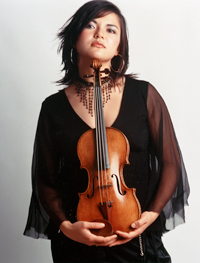by Daniel Hathaway
 “A Taste of Spain” at Blossom on Saturday July 19 featured The Cleveland Orchestra and guest conductor Bramwell Tovey in Iberian-inspired music by two Frenchmen and one authentic Spaniard who went into self-exile in Argentina after Franco won the Spanish civil war. Sunny as the music was, the weather in Cuyahoga Falls was damp and chilly: in his jovial remarks at the beginning of the second half, Tovey welcomed the audience to what indeed felt like a Spanish winter.
“A Taste of Spain” at Blossom on Saturday July 19 featured The Cleveland Orchestra and guest conductor Bramwell Tovey in Iberian-inspired music by two Frenchmen and one authentic Spaniard who went into self-exile in Argentina after Franco won the Spanish civil war. Sunny as the music was, the weather in Cuyahoga Falls was damp and chilly: in his jovial remarks at the beginning of the second half, Tovey welcomed the audience to what indeed felt like a Spanish winter.
Tovey’s own selections from the two suites that Georges Bizet’s friends fashioned from the music from Carmen opened the program with familiar scene-setting tunes and arias sans singers. The March of the Toréadors; Prélude and Aragonaise; Intermezzo; Dragons d’Alcala; Habanera and Danse Bohème were all treated to colorful, characterful performances, with splendid solo work by oboist Jeffrey Rathbun, flutist Marisela Seger, and wonderful section solos from the bassoons. If the percussion got a bit frisky in the last selection, that only added to the excitement.
Camille Saint-Saëns’s third violin concerto was on-topic this evening because it was written for the Spanish virtuoso Pablo de Sarasate. At first wielding a dark, passionate tone, Karen Gomyo later brought fleet and sweet fingerwork to the opening movement and made a ravishing moment out of the end of the second, which pairs “artificial” harmonics in the violin with low notes on the clarinet. Her gripping cadenza and glimmering high notes introduced a finale bursting with hummable tunes. Aside from a few imprecise arrivals and a bit of momentary confusion in the last movement recapitulation, Tovey led a sensitive performance which gave Gomyo solid support and generally allowed her to be heard over the orchestra.
Tovey’s post-intermission talk — eleven minutes’ worth of witty commentary — retold the story of Pedro Antonio de Alarcón’s El Corregidor y la molinera. Manuel de Falla originally set this entertaining farce to music as a pantomime. He and Sergei Diaghilev later refashioned it into the ballet, Le Tricorne (The Three-Cornered Hat), which premiered in London in 1919. Though often played as one of two suites, Tovey chose to present the complete, thirty-five minute score.
After an arresting call to order by trumpet and timpani, De Falla’s evocative score had the members of the orchestra chanting ole! and clapping along with castanets to set the scene for the fun to come. Mezzo-soprano Emily Fons made two alluring cameo appearances, first to warn the listeners that the Devil was asleep but might wake up, then later to warn them that he was out and about.
Intriguing bits of orchestration simulated the creaking of a rusty well pulley, characterized the magistrate with the bassoon and suggested other plot twists through oboe and English horn solos. The secret police came knocking with the opening notes of Beethoven’s fifth.
All of this was great fun, and was vividly brought to life by the orchestra, but as the story scrolled by, you began to appreciate why the music from The Three-Cornered Hat is most often played as excerpts: without the visual dimension provided by dancers, the piece begins to lose its focus after a while. Still, the final jota brought it to a festive conclusion that took quite a bit of the chill off the air on Saturday.
Published on ClevelandClassical.com July 22, 2014.
Click here for a printable copy of this article.


